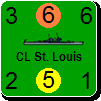Klydon
Posts: 2251
Joined: 11/28/2010
Status: offline

|
There have been some interesting posts and such about where the Germans should put their main effort(s) and what should be the main targets of the 1941 campaign.
I think most have Leningrad as a target since it has tangible benefits in releasing the Finns, which help tremendously with the first winter and also allow the Germans to redeploy at least 1 army to other parts of the line.
Moscow seems to have taken a back seat for most since there are no additional benefits in taking it other than the dislocation of industry, etc. In addition, because there are so many re-enforcements that appear in the immediate area, even a determined drive will meet stiff resistance on the land bridge area and continuing forward.
The south typically gets early attention simply because there are a ton of Russian units that start there and the more you can put out of action in the first couple of turns, the better. If you don't do it, the attack in the south is going nowhere very fast at all with bad results later on in the campaign.
Now, looking at all this from an economic stand point of view is a bit harder because it isn't very clear what can be done to cripple/slow down the Russian economy beyond capturing oil. Getting to Baku is not happening in 1941 and likely not to happen given Russian competent play, so I don't know that it can even be brought up for discussion. That leaves manpower, heavy industry, armaments, and resources as the other legs of the Russian economy.
I have divided up my study into thirds. The north third is basically west of Moscow and north of Torzhok. Center zone includes Torzhok to just north of Kiev and includes Moscow and west. South includes Kiev and south and west of Moscow (Note, this means Stalino is not included in the south initial area, but more on that later).
First off, you can disregard ever putting a meaningful dent in Russian manpower. They start with 3836. Couple with the fact that even if you have a surrounded Russian city, they still get to escape, it makes it very hard to "cripple" the manpower. While I did not count the tiny villages (north has little in the way of village population with center and south having a fair amount), I did add up all the cities in each area. North has 100, center 267 and south 217. This is about 15.2% or so, but again, a lot of it leaves and migrates elsewhere, so it isn't even that much.
Heavy industry: Russians start with 236 total. The only industry in the north is Leningrad with 8 points. Center has 31 with greater Moscow at 9 and the south with 33 with the biggest chunk being a 5. Both the center and south have over 13% each. Add it all together and you get around 30%. At 10k a wack to move, it is hard to get it all moved. Part of the issue for the center is that the majority of the industry there is within 10 hexes of Moscow. Only Minsk and Mogilev (total of 7) are under any real early threat. The industry in the south has a lot of it west of the river or right on the river.
Armaments: This (in my thinking) is one of the weak points of the Russian economy that if you get enough of it out of action, it will have an immediate and absolute effect on the Russian army. Without armaments, it will be difficult for the Russians to build all those guns they need to blow up the Axis with and it will also be harder to take advantage of the manpower they have to replace losses (IE, make rifles). The Russians start with 370 points. Greater Leningrad has 15 for 4% of the pie. The Greater Moscow area has 20 while the center area has a total of 50 for a 13.51% share. The south has D town and Kharkov at 16 and 15 as its two leaders while the entire area has 63 for a 17% share; significantly more than the center. Should you also include the Stalino area, Rostov, and Voroshilovgrad (just outside of our southern boundry), another 56 are located in this tiny area, which represents another 15% of the armaments industry. Taking north, center and south will be around 34.5%. Include Stalino, Rostov, and Voroshilovgrad and you are very close to 50%. At 6k a wack, they are easier to move than heavy industry. Like heavy industry, most of the center armaments are within 10 of Moscow while in the south, they are spread pretty evenly with most on or west of the river.
Resources: 196 to start with. The only area that offers resources is the south with 18 or roughly 9%. Resources are few and far between to get and much of the bigger producers are off map, so being able to harm the Russian economy in a meaningful way through capturing resources seems to be something that isn't going to happen.
Now, while I have presented a lot of numbers and made it sound in terms that the Russians can't move anything by rail, we all know they can and that most games feature very little getting run over by the Germans (About the only given is Minsk). In reality, the Russians can afford to move around 8 HI and 8 armaments each turn and they also have other factories to worry about, like the KV factory in Leningrad and the T34 factory in Kharkov being two of the huge factories they want to get moved out should those areas be directly threaten. Moscow and Leningrad have some other industry that need to be moved as well. The 8 HI and 8 armaments represent 128k of rail cap. This means that some troops coming in from the east will be walking and while some essential troop movements can take place, the Russians moving mass amounts of troops around is likely going to pay for not moving industry.
To me, grinding all this stuff out just sort of confirms my thought that the Germans need to make their main effort in the south. I still think Leningrad is a legit target to free up the Finns and to act as an anchor for the German left flank. While threatening Leningrad (and north) doesn't do much in terms of the war on the economy, there is some pressure there since the Russian must pay attention to it and getting the 8 HI, 15 armaments, the KV factory and some of the other stuff out of there will occupy a fair amount of rail cap. It could also make for an interesting situation should the Germans consider screening Leningrad and doing a "Marcks plan" with a strong drive in the center and south.
I also think this is a good point for the Russians in that if they have to choose between armaments and HI, I think you save the armaments first because more of it is at risk.
|
 Printable Version
Printable Version













 New Messages
New Messages No New Messages
No New Messages Hot Topic w/ New Messages
Hot Topic w/ New Messages Hot Topic w/o New Messages
Hot Topic w/o New Messages Locked w/ New Messages
Locked w/ New Messages Locked w/o New Messages
Locked w/o New Messages Post New Thread
Post New Thread